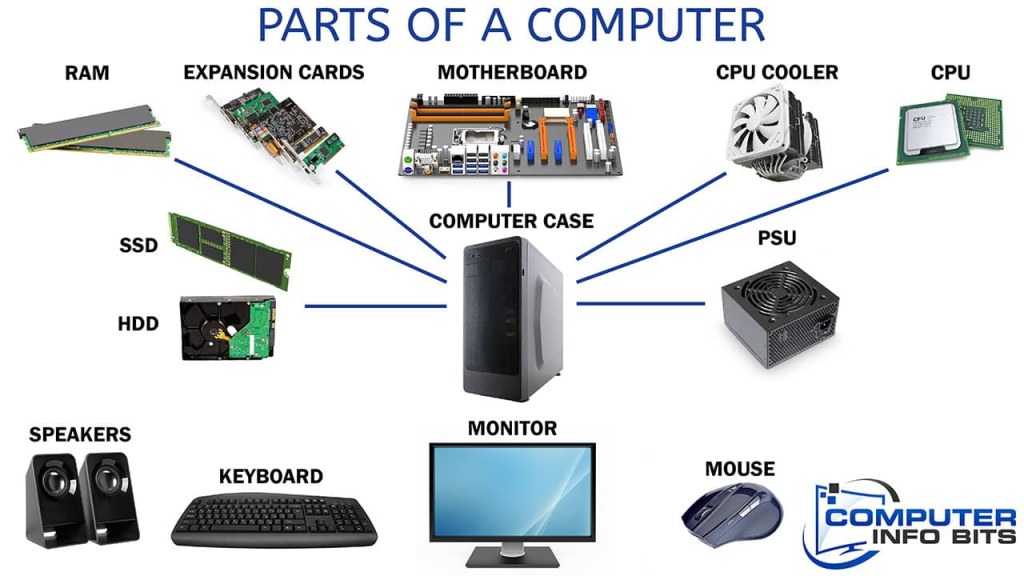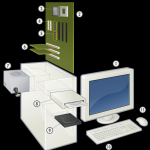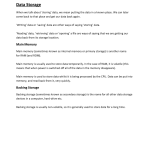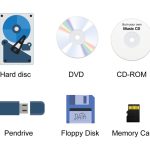Unveiling The Power: Exploring Computer Hardware’s 3 Components
Computer Hardware: The Essentials
An Introduction to Computer Hardware Components
Greetings, Readers! Today, we will delve into the fascinating world of computer hardware and explore its three essential components. As technology continues to evolve, understanding the basics of computer hardware becomes increasingly important. Whether you are a tech enthusiast or a professional in the field, this article will provide valuable insights into the key components that make up a computer system.
2 Picture Gallery: Unveiling The Power: Exploring Computer Hardware’s 3 Components


The Three Components of Computer Hardware
Before we dive into the details, let’s first understand the three main components of computer hardware. They are:
1. Central Processing Unit (CPU) 💻

Image Source: elluminetpress.com
2. Random Access Memory (RAM) 📈
3. Storage Devices 📁
The What, Who, When, Where, Why, and How of Computer Hardware
Now, let’s explore each of these components in detail:
What is a Central Processing Unit (CPU)?

Image Source: computerinfobits.com
The CPU, often referred to as the brain of the computer, is responsible for executing instructions and performing calculations. It interprets and carries out the commands from the computer’s software and controls the overall operation of the system.
Who Needs a Central Processing Unit (CPU)?
Every computer, regardless of its purpose or size, requires a CPU. From personal laptops to supercomputers, the CPU is an essential component that enables the execution of tasks and applications.
When Was the Central Processing Unit (CPU) Invented?
The concept of a CPU was introduced in the early days of computing. The first electronic general-purpose digital computer, known as ENIAC, developed in the 1940s, featured vacuum tube-based CPUs. Over the decades, CPUs have undergone significant advancements in terms of size, speed, and capabilities.
Where Can You Find a Central Processing Unit (CPU)?
A CPU is typically housed within the computer’s central processing unit, which is a rectangular chip mounted on the motherboard. From desktop computers to servers, CPUs are found in various computing devices.
Why is the Central Processing Unit (CPU) Important?
The CPU plays a critical role in determining the speed and performance of a computer. Its processing power affects tasks such as multitasking, gaming, video editing, and more. A powerful CPU can handle complex operations quickly, leading to a smoother user experience.
How Does a Central Processing Unit (CPU) Work?
The CPU consists of millions, if not billions, of transistors that perform basic logical and arithmetic operations. It fetches instructions from memory, decodes them, and executes them accordingly. It also communicates with other hardware components to complete tasks efficiently.
What is Random Access Memory (RAM)?
RAM, also known as memory, is a temporary storage space that allows the computer to access data quickly. It holds the instructions and data that the CPU needs to perform its tasks. Unlike storage devices, RAM loses its data when the computer is powered off.
Who Needs Random Access Memory (RAM)?
Every computer requires RAM to operate efficiently. From casual users browsing the internet to professionals running resource-intensive applications, having sufficient RAM is crucial for smooth performance.
When Was Random Access Memory (RAM) Invented?
The concept of RAM dates back to the early days of computing. The first practical form of RAM was introduced in the mid-20th century, with magnetic core memory being one of the early technologies used. Since then, RAM technology has evolved, with advancements such as dynamic RAM (DRAM) and synchronous dynamic RAM (SDRAM) becoming prevalent.
Where Can You Find Random Access Memory (RAM)?
RAM modules are typically inserted into slots on the computer’s motherboard. The number of RAM slots and the maximum amount of RAM the system supports depend on the motherboard’s design and specifications.
Why is Random Access Memory (RAM) Important?
RAM plays a crucial role in determining a computer’s overall performance and responsiveness. It allows the system to store and access data quickly, reducing the need to rely solely on slower storage devices. More RAM enables users to run multiple applications simultaneously and handle complex tasks efficiently.
How Does Random Access Memory (RAM) Work?
When the computer is turned on, the operating system and other software are loaded into RAM. The CPU then accesses the required data and instructions from RAM, allowing for faster execution. The speed and capacity of RAM greatly influence the system’s performance.
What Are Storage Devices?
Storage devices, as the name suggests, are used to store data in a more permanent manner. Unlike RAM, storage devices retain data even when the computer is powered off. They come in various forms, including hard disk drives (HDDs), solid-state drives (SSDs), and optical drives.
Who Needs Storage Devices?
Storage devices are essential for anyone who needs to store and retrieve data on their computers. From personal files and documents to large databases and media libraries, storage devices provide the necessary space to keep data safe and accessible.
When Were Storage Devices Introduced?
The history of storage devices can be traced back to the early days of computers. The first magnetic storage device, the magnetic drum, was introduced in the 1950s. It was followed by other technologies such as magnetic tape, floppy disks, and hard disk drives. In recent years, solid-state drives have gained popularity due to their faster speeds and improved reliability.
Where Can You Find Storage Devices?
Storage devices can be found both internally and externally in computers and other electronic devices. Internal storage devices, such as hard drives or SSDs, are typically installed inside the computer’s casing. External storage devices, such as portable hard drives or USB flash drives, can be connected to the system via USB ports.
Why Are Storage Devices Important?
Storage devices provide a means to store and access data over an extended period. They allow users to save files, install software, and keep valuable data secure. The capacity, speed, and reliability of storage devices are crucial factors to consider when choosing the right one for your needs.
How Do Storage Devices Work?
Storage devices use various technologies to store and retrieve data. Hard disk drives, for example, utilize magnetic storage and spinning platters to write and read data. Solid-state drives, on the other hand, rely on flash memory chips to store data electronically. Each technology has its advantages and limitations, impacting factors such as speed, durability, and cost.
Advantages and Disadvantages of Computer Hardware Components
Now, let’s examine the advantages and disadvantages of the three computer hardware components:
Advantages of Central Processing Units (CPUs)
👍 CPUs provide the computational power necessary for running complex tasks and applications.
👍 They enable multitasking, allowing users to run multiple programs simultaneously.
👍 CPUs are continually advancing, offering faster speeds and improved efficiency.
👍 They are compatible with a wide range of software and operating systems.
👍 CPUs can be upgraded or replaced, allowing for future system improvements.
Disadvantages of Central Processing Units (CPUs)
👎 High-performance CPUs can be expensive, limiting affordability for some users.
👎 CPUs generate heat, requiring adequate cooling to prevent overheating.
👎 Overclocking CPUs for higher performance may result in reduced stability and lifespan.
Advantages of Random Access Memory (RAM)
👍 RAM provides fast data access, improving overall system performance.
👍 More RAM allows for smooth multitasking and faster application loading times.
👍 RAM is easily upgradable, allowing users to increase their system’s performance.
👍 It is non-volatile memory, ensuring data is retained even during power outages.
👍 RAM plays a crucial role in gaming, providing smoother graphics and reducing lag.
Disadvantages of Random Access Memory (RAM)
👎 RAM is volatile memory, meaning data is lost when the computer is turned off.
👎 High-capacity RAM modules can be expensive, especially for professional applications.
👎 The amount of RAM a computer can support is limited by the motherboard’s specifications.
Advantages of Storage Devices
👍 Storage devices offer high-capacity storage, allowing for vast amounts of data to be stored.
👍 They provide long-term data retention, ensuring data integrity over extended periods.
👍 Storage devices are available in various form factors, catering to different needs.
👍 Solid-state drives offer faster data transfer speeds and improved durability.
👍 External storage devices provide portability, allowing data to be accessed on different systems.
Disadvantages of Storage Devices
👎 Mechanical storage devices, such as hard disk drives, are susceptible to physical failure.
👎 High-capacity storage devices can be expensive, especially SSDs with large capacities.
👎 Storage devices have limited lifespans, as they can only withstand a finite number of write cycles.
Frequently Asked Questions (FAQ)
Here are some commonly asked questions about computer hardware components:
1. Can I upgrade my CPU?
Yes, CPUs can often be upgraded. However, compatibility with the motherboard and socket type must be considered when selecting a new CPU.
2. How much RAM do I need?
The amount of RAM you need depends on your specific needs. For casual users, 8GB to 16GB is usually sufficient, while professionals working with resource-intensive applications may require 32GB or more.
3. Can I mix different types of RAM?
While it is possible to mix different types of RAM, it is generally recommended to use identical modules to ensure compatibility and optimal performance.
4. What is the difference between an HDD and an SSD?
HDDs use spinning platters and magnetic storage to read and write data, while SSDs rely on flash memory chips. SSDs offer faster speeds, better durability, and quieter operation compared to HDDs.
5. Should I choose SSD or HDD for my storage needs?
If speed and durability are important to you, SSDs are the better choice. However, if you require large storage capacities at a lower cost, HDDs are more suitable.
Conclusion
In conclusion, understanding the key components of computer hardware is essential in today’s tech-driven world. The CPU, RAM, and storage devices form the foundation of any computer system and greatly influence its performance. By knowing the advantages, limitations, and functions of these components, you can make informed decisions when building or upgrading your computer. So, whether you’re a gaming enthusiast, a creative professional, or simply a casual user, remember the importance of computer hardware in unleashing the full potential of your device. Upgrade wisely, explore new possibilities, and embrace the digital future!
Final Remarks
Friends, we hope this article has provided you with valuable insights into the world of computer hardware components. It is crucial to keep in mind that technology is constantly evolving, and new advancements are made regularly. Stay curious, stay updated, and continue exploring the ever-expanding realm of computer hardware. Please note that the information provided in this article is for educational purposes only, and individual requirements may vary. Always consult with professionals or conduct thorough research before making any hardware-related decisions. Happy computing!
This post topic: Computer Hardware



